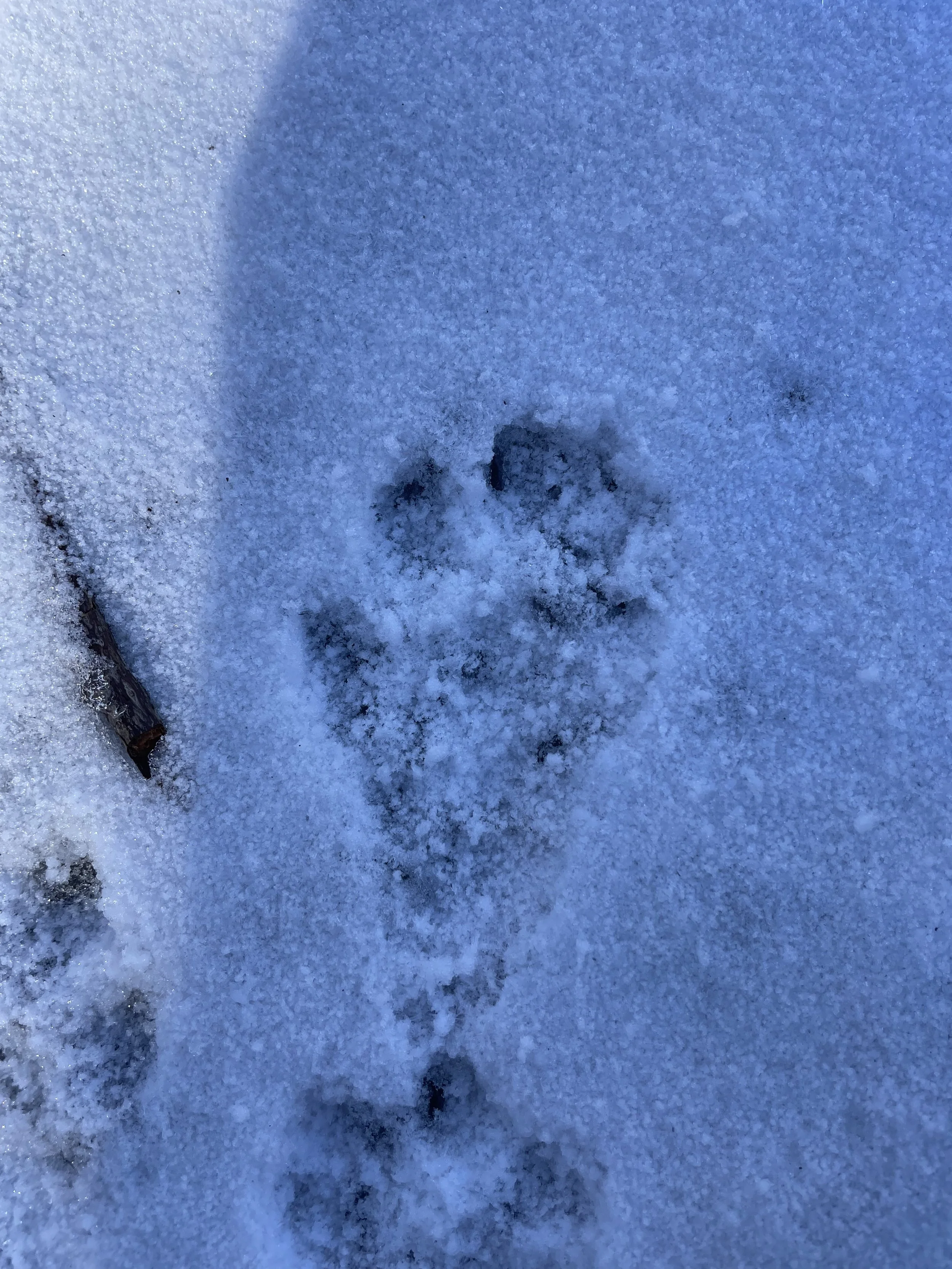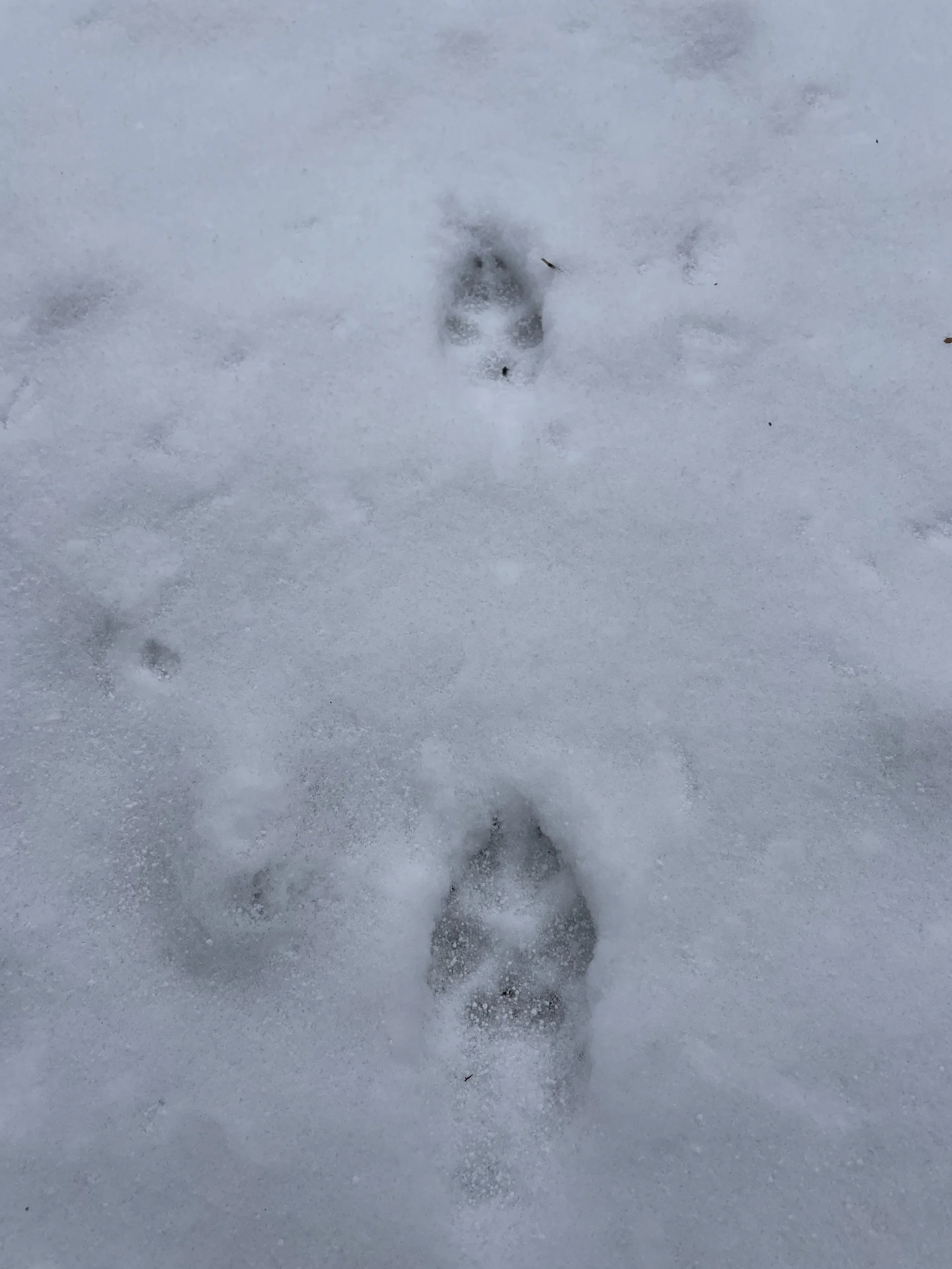Mysteries Afoot: Identifying Appalachian Animal Tracks
Looking around as you walk through the forests of the Appalachian Mountains will grant you sights of tree diversity and breathtaking views. You may even get lucky and see some of the elusive–yet abundant–wildlife that call the Blue Ridge home. However, when you take the time to look down, you get to see the stories of these animals unfold. In the mud of a wet part of a trail, the silt on the side of a stream, or in the snow during a cold winter day, you can clearly see the traces of animals roaming the area before you.
Bear tracks along the Virginia Creeper Trail.
What are animal tracks?
Animal tracks are imprints made by animals moving across the ground. Most often these tracks are impressions of the animal’s feet left behind on soft surfaces, but can also represent any part of the body that touched the ground.
Animal tracks are an interesting tool for anyone with a keen eye who wants to learn more about the habits and behaviors of our animal neighbors. These tracks can come in a variety of shapes, sizes, depths, and patterns, depending on the species that left them and what they were doing when the tracks were created. By paying attention to the different features of tracks, we can explore which species left them and learn why the tracks formed in the ways they did.
For instance, the size of a deer track (a hoof distinctly split into two cloven halves) gives the observer hints as to the age and gender of the stepper, as a smaller footprint likely comes from a juvenile animal, and bucks typically have larger feet than does when fully grown. The gait pattern and depth of the tracks can lead to conclusions about how the animal was moving and how fast they were traveling.
Where is the best place to find animal tracks?
You can find animal tracks pretty much anywhere! The easiest tracks to spot are the ones left in soft and malleable soil types. Soil after rainfall is especially saturated with water, allowing animal feet to sink better into it. But of course, snow tops the charts for best track substrate. When snow is on the ground, tracks abound! There’s no avoiding leaving a trace behind when snow is pushed down with every step and there’s no leaf litter or debris to hide a path.
Regardless of the weather, one of the best spots to check for tracks is next to a body of water, along the muddy banks of a river, creek or lake. Many animals rely on these places for their drinking water, and often this soil will be composed of soft silt or sand, which make for excellent tracks.
At Blue Ridge Discovery Center, we have a “track trapper,” which is essentially a sandy area by Della’s Branch Nature Trail. The idea is that when an animal walks to the stream to take a drink, it will leave behind a footprint or two for us to identify!
Identifying animal tracks
So how can you tell what animal left what tracks? There are some key features that can help identify which tracks belong to which critter.
The main features of animal tracks are the toes, metacarpal pad (or paw pad, for the not rigorously academic tracker), claws, and negative space.
A sketch of a bear print demonstrating the different features to look for when identifying animal tracks.
Count toes and claws
When looking at any given track, the first questions that come to the trained tracking mind are: How many toes does this animal have? What shape is the pad? Does the animal have claws? If so, how big are they?
It can be helpful to start by measuring and counting the different details of animal tracks, ruling out certain species based on the presence or absence of certain features.
Feline and canine tracks show four toes, but bear, beaver, raccoon, and opossum tracks show five. Canines, bears, and skunk tracks show claws; bobcat tracks do not.
Consider negative space
Negative space is a little less obvious, but it's everything else that isn’t pushed down in between each of the other features. This is the space between each of the toes, between the toes and the pad, or between the toes and the claws. Within this negative space you can find patterns that correspond with the feet of certain species, including features such as webbing.
Another thing to keep in mind is that many animals have very different tracks for their front feet and their hind feet, so while it could look like two different animals, it could very well be the same one!
Measure the track size
Size is a great starting point for track identifcation. It’s helpful to carry a ruler and field guide to reference when determing which tracks belong to who!
Look for gait patterns
Animals of the same species often move in a similar way, referred to as gait. When multiple tracks are present, you can use these patterns of movement to narrow down the possibilities.
Trackers call some animals “perfect walkers” because they move very efficiently, placing each hind foot in nearly the exact position as the front foot. Coyote, fox, bobcat, and deer tracks tend to represent this precise, zig-zag pattern.
Other animals seem to amble, shifting their weight from side to side as they move, earning them the moniker “waddlers.” Bear, raccoon, opossum, and skunk tracks show all four feet since these animals move deliberately.
Still other animals are “bounders” that leap with each step, leaving behind a pair of paws at each touchdown. Mustelids like otters and weasels leave behind this adorable track pattern.
Finally, “hoppers” (rabbits, chipmunks, and other rodents) jump in such a way that their back feet land ahead of their front feet, making for an interesting track pattern that looks almost like a game of leapfrog.
Comparing tracks
Some tracks can look very similar, so there are important differences to consider when trying to figure out just whose footprint you’re looking at. The tracks of a coyote can look very similar to the tracks of a domestic dog, for instance.
Size can be helpful for distinguishing these two because coyotes are larger than most medium sized dogs and always larger than the small breeds. But since some dogs are similar in size to coyotes, you may have to look at the toes, claws, and track pattern for a definitive answer.
Dogs usually have widely splayed toes, blunt claws, and a sloppy track pattern, whereas coyotes have narrow toes that face forward without splaying, sharp claws, and a neat and straight track pattern.
To a less experienced observer, bobcat tracks could also appear similar to coyote tracks, so you have to look at the claws and the pad. Bobcats, being felines, have retractable claws that tend to not show up in the tracks. Bobcats also have a more lobed pad compared to the coyote's more uniform pad.
Red fox and gray fox tracks can be very hard to distinguish at times, but the red fox has much larger paws and a more triangular pad. With retractable back claws and less furry feet, gray foxes show off more toe visibility and have a more v-shaped pad.
Animal tracks from left to right: deer, bobcat, gray fox, and coyote.
Other factors
Some animals have incredibly unique characteristics that make them stand out from other tracks, allowing for easy identification.
Bears have massive paws with a wide pad and toes that face forward, each with a blunt claw. Beaver tracks show off the large, flat hind feet in comparison to their smaller front feet. Skunks have a very visible imprint of their heel in most of their tracks, which varies between the front and back paws.
A bullfrog track shows off their thin, long toes on their hind feet and the inward facing placement of their front feet. Small tracks with a line running down the middle could mean you have a set of mouse or vole tracks, as their tail drags along behind them as they walk. Cloven hoofprints are almost always deer tracks, which can be easily distinguishable from large domesticated animals like horses and pigs. The wild turkey is a staple track for most hunters given the three toes in front and the one toe behind them along with the large size of their feet.
So next time you’re taking a stroll through the woods, take your eyes off the views for a moment and look down. You may get to read an animal’s story in the language of tracks! And don’t worry, while the tracks may fade, the views aren’t going anywhere.









